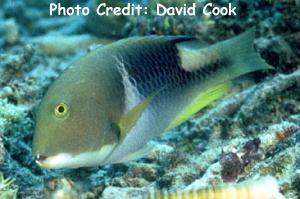
By Bob Goemans

Not Reef Tank Suitable
Likely Fish-Only Tank Suitable
Range: Indo-West Pacific Ocean: Sri Lanka to Southern Japan, and south to New Caledonia.
Size: 20 inches (50 cm)
Natural Environment: Inhabits lagoon reefs and reef flats and often found in seagrass beds. Usually found at depths between 3 – 85 feet (1– 25 m) where it feeds on benthic hard-shelled invertebrate.
General Husbandry: Rarely seen in the trade having an olive-green body with a black blotch on the aft mid body, white underbelly and head, and a yellow tail.
Best maintained in large fish-only aquariums, which should provide rocky hiding places and lots of open swimming area.
As to diet, products such as marine fish and crustacean flesh, clams, and other marine meaty foods should make up the majority of their diet and be enriched and chopped into fine pieces and fed twice daily.
May be difficult to feed in the early days in the aquarium, as it’s often shy when first introduced into the aquarium. If so, (if small live marine fish are not available) live glass/grass shrimp, small crabs, e.g., fiddler crabs and/or live guppies/mollies may be needed to sustain the fish. Will become bolder as it ages.
Taxonomy:
Order: Perciformes
Suborder: Labroidei
Family: Labridae
Genus: Choerodon
FYI: Will eat smaller fishes, snails, tubeworms, ornamental shrimps, crabs, brittle stars, sea stars and urchins.
May spit a jet of water at the surface. It’s not known why they do this.
Usually sleep in caves and crevices.
Hardy species. One per aquarium
May disturb sandbeds by using its pectoral fins to excavate depressions in the sand to find buried prey.
Experience Level: Intermediate
Temperament: Semi-aggressive
Diet: Carnivore
Coral Safe: Yes
Fish Safe: With caution
Invertebrate Safe: With caution
Acclimation Time: 30 minutes+
Aquarium Environment: Fish-only aquarium
Tankmates: Moderately aggressive
Minimum Tank Size: 150 gallons
Temperature Range: 74 - 82°F (23 – 27°C)
Specific Gravity: 1.020 - 1.026
pH: 8.0 - 8.5
